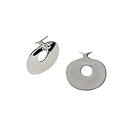Those earrings, of a very pure design, must be older than Croesus, whose name still evokes treasures of gold and precious stones.
He was one of the most ostentatious rulers of Lydia, a very ancient kingdom in Asia Minor, bordered to the north by Mysia, to the west by the Aegean Sea, to the east by Phrygia...
Read more
Those earrings, of a very pure design, must be older than Croesus, whose name still evokes treasures of gold and precious stones.
He was one of the most ostentatious rulers of Lydia, a very ancient kingdom in Asia Minor, bordered to the north by Mysia, to the west by the Aegean Sea, to the east by Phrygia, and to the south by Caria, which was on the other side of the river Meander.
The original jewellery was found in a tomb near Sardis, the Lydian capital, along with two similar, but much smaller pendants, one of which was ring-shaped, the other a moulded disc. They were probably worn on the chest, as on the island of Cyprus in the 6th century. Their symbolic meaning remains a mystery.
Lydia was independent and prosperous until 548 B.C. In that year, Croesus was defeated by Cyrus the Great and his kingdom became just another province of the Persian Empire
Close



